Motion
Motion indicates change over time. Motion can indicate change of position or the ‘movement’ of a figure within the visual field, and motion can indicate change of size or the growth of a figure within the visual field. It is important to note that motion does not equate time and time does not equate motion; a figure could be stationary within the visual field over time and thus no motion occurs. Motion is typically described in terms of velocity, acceleration, displacement (change of position), and time.
Applied Concept: This can either be actual movement or it can be implied movement. The arrangement of the elements of an image can create a sense of motion; the placement of lines, shapes, and textures cause the eye to move around the work or produce the illusion of action.
Motion is a 'low-level' aspect of visual perception. Awareness of motion occurs shortly after brightness awareness, which is the first level of perceptual awareness. As such, motion is regarded as one of the primary structures in creating figures.
Motion can be described by using the various descriptors: size, proportion, shape, position, direction, orientation, texture, speed, and stasis. In the case of motion, any change in descriptor can be described. If a descriptor is unchanged, motion is not occurring and therefore it can be described without referring to motion at all. While this may seem obvious, there can be a tendency to describe various shapes present in a movie, for example, in relation to motion even when there is no motion.
Size
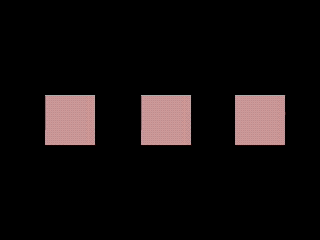
In this example, the square to the left becomes the primary figure within the sequence because of motion. The motion is a change of size from small to large and back again. If you stop the movie at the beginning or end, there is no clear primary figure due to all three squares being fundamentally identical (except for different positions).
Proportion

In this example, the square to the left becomes the primary figure within the sequence because of motion. The motion is a change of proportion from a square to a vertical rectangle, back to a square, then to a horizontal rectangle. While there might be a tendency to describe this as a change of size, the area of the shape is unchanged. If the square was 1 square inch in volume, the change in proportion retains the 1 square inch of volume. It should be noted, however, that it IS a change in size as well because the shape becomes narrower or wider, but the more specific descriptor is Proportion.
If you stop the movie at the beginning or end, there is no clear primary figure due to all three squares being fundamentally identical (except for different positions).
Shape
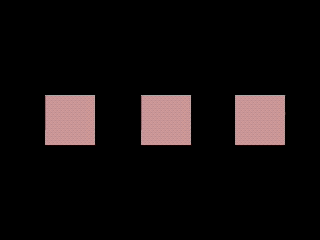
In this example, the shape to the left becomes the primary figure within the sequence because of motion. The motion is a change of shape from a square to (roughly) a circle and back again. If you stop the movie at the beginning or end, there is no clear primary figure due to all three squares being fundamentally identical (except for different positions).
Position

In this example, the square in the center becomes the primary figure within the sequence because of motion. The motion is a change of position, moving up and down. Once again, if you stop the movie at the beginning or end, there is no clear primary figure due to all three squares being fundamentally identical (except for different positions).
Direction
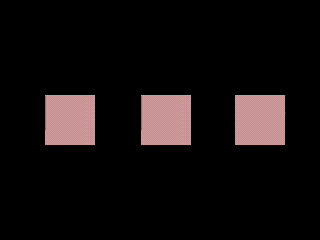
In this example, the square in the center becomes the primary figure within the sequence because of motion. The motion is a change of direction, rotating clockwise and counterclockwise. Once again, if you stop the movie at the beginning or end, there is no clear primary figure due to all three squares being fundamentally identical.
Orientation
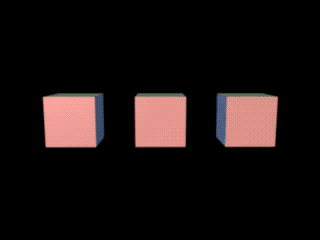
In this example, the square to the right becomes the primary figure within the sequence because of motion. The motion is a change of orientation. Orientation requires a sense of top/bottom, front/back, or left/right. A series of three squares would not illustrate orientation because there is no distinct top or bottom, front or back, left or right. The faces of the cube are colored differently to provide some sense of facing – red is front-back, green is top-bottom, and blue is left-right. Once again, if you stop the movie at the beginning or end, there is no clear primary figure due to all three squares being fundamentally identical.
Texture
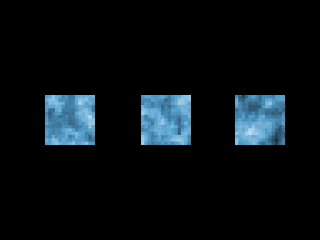
In this example, the square in the center becomes the primary figure within the sequence because of motion. The motion is a change of texture. The overall brightness and hue of the squares remains constant but the texture changes over time. If you stop the movie at the beginning or end, there is no clear primary figure due to all three squares being fundamentally identical, with slight texture variations.
Speed

In this example, the square to the right becomes the primary figure within the sequence because of motion. The motion is a change of speed and the speed is based on a motion of changing direction (rotation, in this case). All three squares are rotating clockwise, but because the right square is rotating much faster, it becomes discontinuous.
Stasis
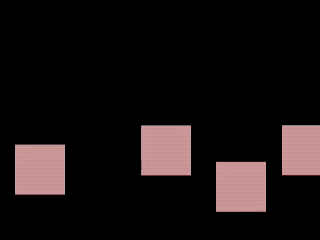
In this example, the square to the far left becomes the primary figure within the sequence because of stasis. Stasis is an explicit example of speed motion. Stasis is the absence of motion when there is other motion occurring. While a painting could be described as being in stasis, because there is no other motion inherent in the painting, stasis would not be applicable. In this example, all of the squares are moving except the square to the far left. The motion of the squares could be described as similar in direction and speed and more specifically, motion of position.